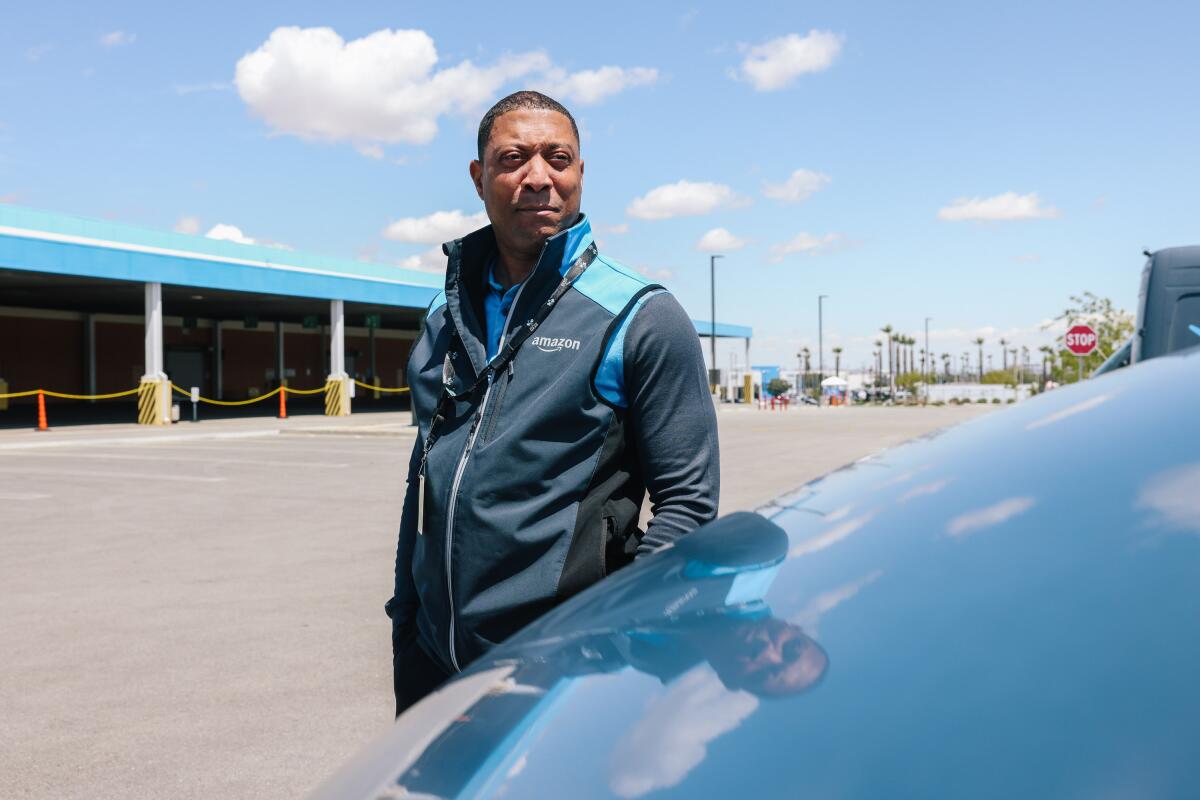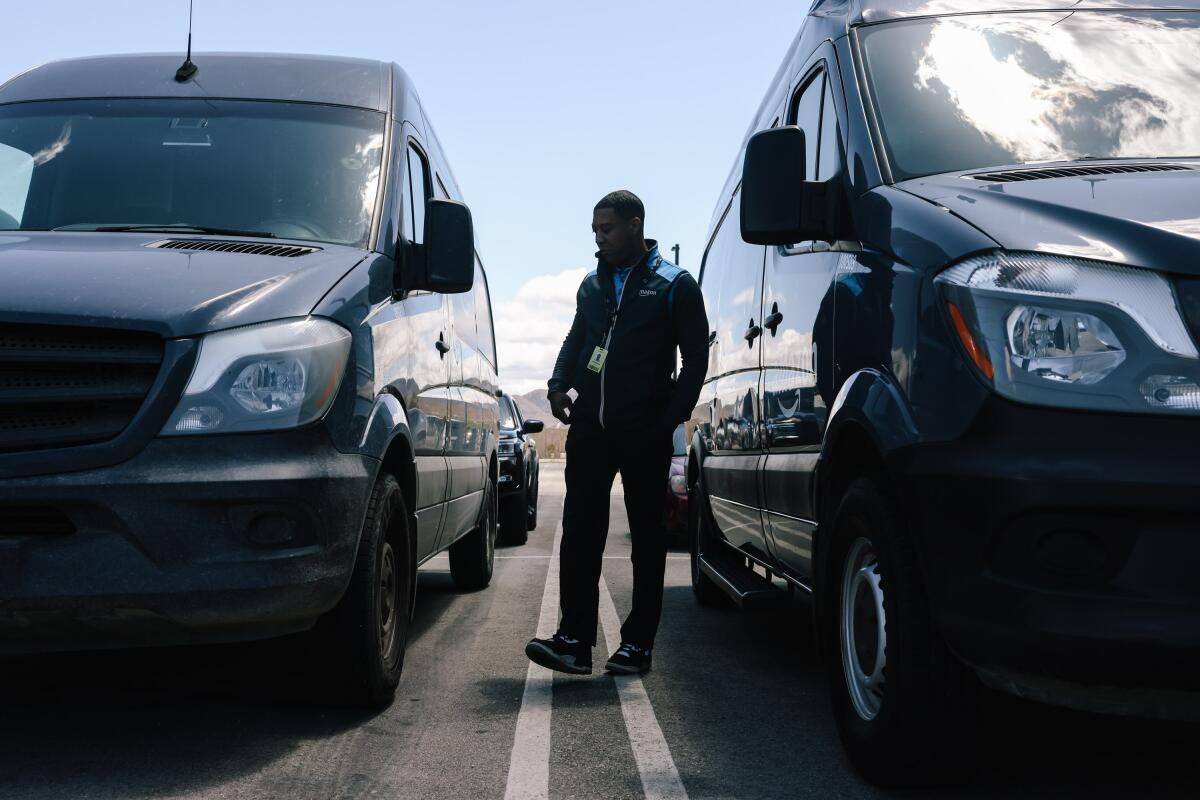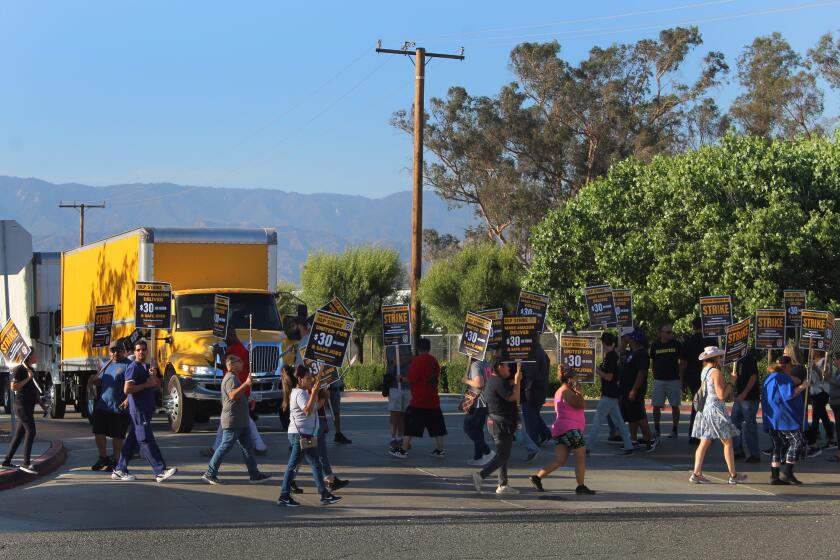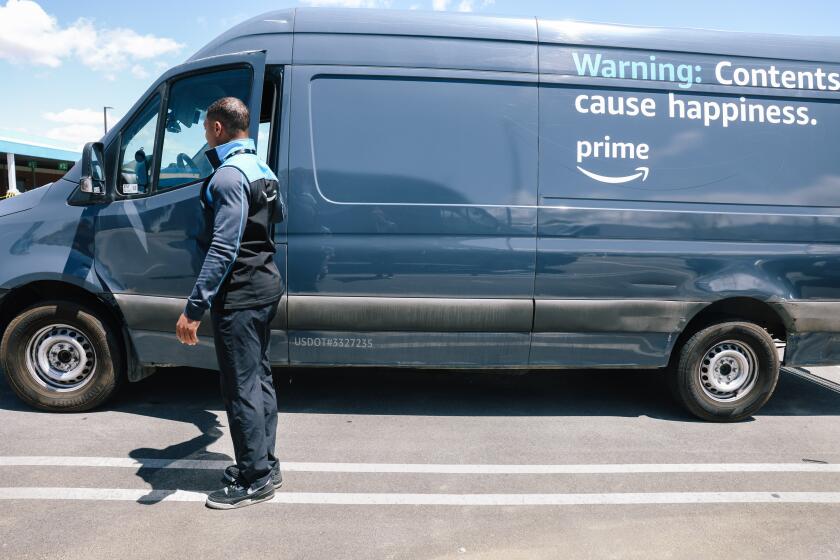Amazon demands a lot from its drivers. Now they’re pushing back

- Share via
Rajpal Singh sweltered on his routes, delivering hundreds of packages every day for Amazon to homes on twisty dirt roads in the hills and valleys surrounding Lancaster and Palmdale. Temperatures in his van commonly climbed above 100 degrees.
The $19.75 hourly wage Singh said he was paid by Battle-Tested Strategies, a delivery company that counted Amazon as its only client, didn’t make up for the grind of the job.
“None of us felt we were being paid fairly,” Singh said of other drivers at the company. “That’s barely a living wage. Anyone who lives in L.A. County knows the truth, that most of us are going around figuring out which bills we are going to pay, how we are going to make sure there’s food on our table.”
Fed up, Singh and other drivers banded together. They demanded better working conditions and later took steps toward unionizing. Not long after Amazon officials got wind of the agitation, the retail giant canceled its contract with the company, forcing it to close and putting Singh and the others out of work.
Until getting laid off, Singh was part of an army of drivers who make up the backbone of Amazon, a juggernaut that totaled nearly $575 billion in revenue last year. A ubiquitous presence on city, suburban and country roads across the U.S., they race daily in a nonstop push to keep pace with the insatiable demand for doorstep delivery that Amazon itself helped create.
Long-running frustrations over pay and working conditions underscore tensions built into the delivery system Amazon has constructed, in which it contracts with a vast network of independent companies like Battle-Tested Strategies instead of hiring drivers directly. The friction has escalated in recent months as drivers increasingly are following the lead of peers like Singh in pushing back against the arrangement, which they say has allowed Amazon to skirt responsibility for workplace issues. A handful of unionization efforts have taken root around the country, with drivers emboldened by recent findings by the National Labor Relations Board that called into question whether Amazon can keep its drivers at arm’s length.
Subcontracted Palmdale Amazon drivers were laid off after voting to unionize. Now, they’re joining a nationwide protest for better wages and work conditions.
In one of those rulings, an NLRB regional director in Los Angeles determined last month that Amazon was a “joint employer” of the drivers who delivered packages for the now-defunct Battle-Tested Strategies. And last week, a regional director in Atlanta determined Amazon should be held liable for allegedly making threats and other unlawful statements to drivers seeking to unionize in the city.
Amid the growing unrest, last week the company announced a $660-million investment in its network of delivery companies, called the Delivery Service Partner program. With the infusion, which is intended to boost drivers’ pay, Amazon said it expects the national average pay for drivers to increase by $1.50, to nearly $22 per hour, a 7% increase over last year.
The pay hike, however, appears to have only strengthened the resolve of the International Brotherhood of Teamsters, the powerful union leading the push to organize Amazon’s drivers.
“The trillion-dollar company thinks small raises for drivers will distract them from fighting for fair pay and safe jobs in a Teamster contract,” said Randy Korgan, director of the Teamsters Amazon Division, in an emailed statement.
“If Amazon is serious, they need to put it in writing and respect what these workers are asking for, because every worker knows their word is no good,” he said.
Amazon spokesperson Maya Vautier said the investment in driver pay is not a response to the recent union pressures but part of normal adjustments the company makes to driver pay this time each year. Last year’s increase raised the average hourly pay for a driver by $1, to $20.50.
“We make these investments every year,” Vautier said.
Caught in the middle of the simmering labor fight are owners of the delivery companies.
One of them was Johnathon Ervin, who started Battle-Tested Strategies. The seasoned Air Force veteran and reserve officer was working as a contractor for weapons manufacturer Northrop Grumman when he came across an ad by Amazon in 2018 targeting veterans looking to start their own companies.
Amazon was pitching a new program that offered the chance to start a delivery company for as little as $10,000 in startup costs, Ervin recalled. Ervin traveled to Seattle on his own dime in 2019 for the training Amazon required of its delivery contractors and soon after launched his company. The arrangement required Ervin to hire his drivers and rent delivery vehicles and equipment from Amazon.

His business earned glowing performance reviews from Amazon. In a 2020 newsletter, Amazon championed Ervin as a face of its commitment to Black business owners.
Ervin said his relationship with Amazon soured in the summer of 2022, when one of Battle-Tested Strategies’ drivers had to be taken to the emergency room as a result of heat stress. Amazon’s reaction was to ask when the driver was expected to return to the station, Ervin said.
In a statement, Eileen Hards, an Amazon spokesperson, said the company has taken steps to mitigate heat-related hazards for delivery workers and is “committed to the safety of drivers and the communities where we deliver.” Driver reports of unsafe conditions are reviewed and taken seriously, she said.
In 2022, after Amazon managers heard about the petition for better heat safety measures circulating among his drivers, Ervin said he was required by the company to have one of his supervisors complete an anti-union training with a legal firm Amazon retains for its delivery service partners. Amazon’s overall handling of drivers’ concerns was a red flag, he said.
Hards disputed Ervin’s claim, saying Amazon does not require anti-union training.
“My main duty is the welfare, morale and training of troops. That’s extremely important. It’s in my DNA. And so anybody that works for me, whether it be in the military, or here at Amazon, I see them as my troops, and they need to be taken care of,” Ervin said.
In early 2023, as the drivers were continuing to organize, Amazon began grounding his vehicles for what Ervin described as bogus reasons during daily safety checks that had never raised issues before, such as a scratch on a rear light and a slightly bent license plate. As a result, he was hit with several “breach of contract” notices by the company.
In April of that year, Amazon gave Ervin 60 days’ notice that it was terminating his contract. When his drivers pressed ahead with plans to unionize, which Ervin publicly supported, Hards lashed out at them and Ervin. Battle-Tested Strategies, she said, “had a track record of failing to perform and had been notified of its termination for poor performance well before the union announcement.”
An NLRB regional director found that Amazon is a joint employer for third-party delivery company Battle-Tested Strategies and unlawfully refused to bargain with drivers.
Losing the company was a blow to Ervin, who estimates he had invested $35,000 of his own money to start it up, and saw his dreams for building a successful, profitable company crumble.
“I’ve lost everything,” Ervin said.
Hards disputed Ervin’s allegation that Amazon’s decision to end its contract with his company was tied to his drivers’ efforts to unionize. “Amazon does not retaliate for union organization,” she said in an email.
Although they arrived too late to help him, Ervin said the NLRB’s findings in the case brought by his former drivers was a “monumental victory” that resonates with “every Amazon subcontractor and employee who has felt the heavy hand of intimidation and bullying by Amazon.” The board concluded that as a joint employer of its drivers, Amazon cannot use its network of delivery companies to shield itself from some responsibility for working conditions.
For the record:
7:33 p.m. Sept. 24, 2024An earlier version of this story stated inaccurately that Amazon and the Teamsters are in negotiations as a result of the National Labor Relations Board’s findings.
The NLRB did not find merit to all of the Teamsters’ allegations regarding Battle-Tested Strategies. It dismissed, for example, the claim that Amazon’s decision to end its contract with Battle-Tested Strategies was retaliatory. If the parties do not reach a settlement in the case, the labor agency would issue a formal complaint based on its findings. After that, the case would be heard by an administrative law judge, who could order the company to implement remedies. The judge’s decision could then be appealed to the labor board in Washington.
Other former owners and managers of delivery companies have raised similar concerns about the power Amazon wields over the companies in the Delivery Service Partner program and the implications for driver safety. Some have filed lawsuits alleging unfair treatment, false promises about profits, and unlawful termination of their delivery contracts.

In a proposed class-action suit filed in federal court in Seattle in 2022, Sacramento delivery company Fli-Lo Falcon alleged that Amazon “exercises near complete control” over subcontracted delivery companies, treating them as franchisees without any of the legal protections that designation would afford them.
Over the summer, drivers in Skokie, Ill., went public with plans to join the Teamsters, demanding Amazon recognize their union. Instead, Amazon terminated its contract with the delivery company they worked for, Four Star Express Delivery.
And earlier this month, hundreds of drivers from several delivery companies in Queens, N.Y., staged a walkout to announce they were joining the Teamsters and to demand Amazon negotiate a contract with them.
Amazon, as it has in the past, disputes that subcontracted delivery drivers are employees of Amazon. The company disputes that it cut ties with Four Star Express Delivery, saying instead that Four Star voluntarily exited the program.
“These claims are false and based on either a misunderstanding or intentional misrepresentation of the facts. The truth is that there are multiple independent small businesses that deliver for us ... and none of [the drivers] are Amazon employees,” Amazon spokesperson Mary Kate Paradis said in an emailed statement, referring to the Skokie activity.
The workers in Queens also are not Amazon employees, Paradis said, adding that “the Teamsters are well aware that the NLRB has not ruled that Amazon is a joint employer for these drivers, but they continue to lie because they want to deceive drivers.”
The recent NLRB findings probably helped to boost the burst of union campaigns, said Jake Rosenfeld, a sociologist who studies labor at Washington University in St. Louis.
“History has shown that Amazon is willing to simply sever the contracts of delivery companies whose workers do agree to unionize, so the Teamsters are figuring this is their best shot at making some cracks at Amazon,” Rosenfeld said.
More to Read
Sign up for This Evening's Big Stories
Catch up on the day with the 7 biggest L.A. Times stories in your inbox every weekday evening.
You may occasionally receive promotional content from the Los Angeles Times.













